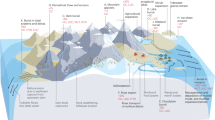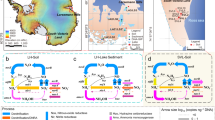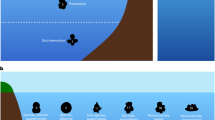Abstract
There has been recent debate over stratigraphic markers used to demarcate the Anthropocene from the Holocene Epoch. However, many of the proposed markers are found only in limited areas of the world or do not reflect human impacts on the environment. Here we show that spheroidal carbonaceous particles (SCPs), a distinct form of black carbon produced from burning fossil fuels in energy production and heavy industry, provide unambiguous stratigraphic markers of the human activities that have rapidly changed planet Earth over the last century. SCPs are found in terrestrial and marine sediments or ice cores in every continent, including remote areas such as the high Arctic and Antarctica. The rapid increase in SCPs mostly occurs in the mid-twentieth century and is contemporaneous with the ‘Great Acceleration’. It therefore reflects the intensification of fossil fuel usage and can be traced across the globe. We integrate global records of SCPs and propose that the global rapid increase in SCPs in sedimentary records can be used to inform a Global Standard Stratigraphic Age for the Anthropocene. A high-resolution SCP sequence from a lake or peatland may provide the much-needed ‘Golden Spike’ (Global Boundary Stratotype Section and Point).
Similar content being viewed by others
Introduction
The Anthropocene has become a term widely adopted by both the scientific community and the media1,2. It reflects the current time of the Earth’s history when human activities have become one of the dominant forces shaping the planet implying that a new geological time division may be required. There has been much debate over the timing of the Anthropocene; some authors have used archaeological evidence to suggest that the rise of human impacts began in the early to mid-Holocene3, ~2 millennia ago4, or from the time of the industrial revolution1. However, mounting evidence suggests that human impacts on the planet at these times were diachronous and highly spatially variable5. There is rising support for the base of the Anthropocene to be placed at ca. AD 1950 that approximates the ‘Great Acceleration’, a time of rapidly increasing and globally-widespread anthropogenic impacts on planet Earth. This includes unprecedented burning of fossil fuels leading to a rapid rise in global atmospheric CO2, deployment of nuclear weapons and pollution from industrial, agricultural and domestic processes5,6. There is a need for a stratigraphic marker that reflects the significant global impact of humans on Earth and defines the Anthropocene. This stratigraphic marker must represent the onset of the Anthropocene in marine and terrestrial sediments and ice, be present across the globe and be related to the types of human impacts that characterize the Anthropocene. Anthropogenic soils4, chemical tracers7 and radionuclides5 have been proposed as Anthropocene markers. However, many of these are diachronous, regionally variable, occur at the wrong time, or require a complex analytical procedure to decipher. The Tambora 1815 volcanic event has also been proposed as a possible marker for dating the onset of the Anthropocene8. This volcanic event is registered in chemical profiles from Greenland and Antartica ice core records; however, tephra from this eruption is only found in Asia9. More importantly, it does not derive from human impacts on the environment that defines the Anthropocene.
An unambiguous ‘index fossil’ of the human activities that have changed the face of planet Earth in recent centuries is therefore needed. Spheroidal carbonaceous particles (SCPs) are a distinct component of black carbon only produced from the high-temperature (>1000 °C) combustion of fossil fuels (coal and oil) (Supplementary file). SCPs are produced as a by-product of energy production as well as heavy industry and have no natural sources in the Quaternary10. SCPs are highly abundant in areas close to pollution sources11,13 and are also found across the continents of planet Earth (Table 1). Importantly, they have also been recorded in remote areas distal from industrial sources including Greenland14, Svalbard15, Arctic Canada16,17 and Antarctica18. Several studies have shown that SCPs are correlated with other types of industrial pollution including sulphur and polycyclic aromatic hydrocarbons (PAHs)13,19. In addition, SCPs are also well-preserved in lake and marine sediments, peats and glacial ice as they are chemically inert, owing to their composition of elemental carbon20,21.
SCPs are suitable indicators for the Anthropocene for the following reasons:
-
1
They are present across the globe (Table 1);
-
2
They are an unambiguous marker of anthropogenic fossil fuel combustion that has changed the composition of our atmosphere and driven recent climate change22;
-
3
They record unprecedented impacts of human activity on the environment;
-
4
They are documented in ice cores, marine and terrestrial sediments;
-
5
They are easily extracted and identified by researchers.
Variation in the timing and extent of coal and oil usage are reflected in temporal differences of the first occurrence (First Occurrence Datum) of SCPs in different regions (Table 1). The peak (acme) in SCP concentration is also variable spatially, reflecting proximity to pollution sources. However, the rapid increase in SCPs reflects the rise to dominance of oil as the major fossil fuel source on Earth22 and mostly occurs in the mid-twentieth century across the globe (Fig. 1) – contemporaneous with the ‘Great Acceleration’3 and rapid increase in global population. The rapid increase in SCPs is thus a key chronostratigraphic marker for the Anthropocene because it is a global signature. We know of only two pre-Holocene occurrences of SCPs in the sedimentary record due to non-anthropogenic phenomena and they both correlate to significant geological timescale boundaries and mass extinctions. SCPs were derived from (I) the combustion of coal by flood basalts at the latest Permian extinction23; and (II) the combustion of fossil organic matter from bolide impact at the Cretaceous-Palaeogene boundary24. Furthermore, it has been suggested that the Cretaceous–Palaeogene examples are easily distinguished from modern SCPs due to a lower burn temperature resulting in lighter colouration of the particles25. We suggest that the appearance of SCPs in Anthropocene sediments will appear geologically instantaneous in the far future.
Kernel density plot of the decade of rapid increase in global SCPs (data are from Table 1). The plot illustrates that the rapid increase mainly occurs in the mid-twentieth century across the globe. The earliest decade was used in the case of the event spanning two decades (e.g. 1950s–1960s).
We propose that lake and/or peatland sequences with detailed SCP records should be used to inform either a Global Standard Stratigraphic Age (GSSA), or used as the Global Boundary Stratotype Section and Point (GSSP) for the Anthropocene. Many lakes and peatlands have continuous sedimentation/accumulation over this time period and deposited an adequate thickness of sediment to capture SCPs. In Britain for example, SCP records commonly begin between AD 1830–186025, somewhat later than the earliest industrialisation. However, the rapid increase in SCPs (AD 1950–1960s) reflects the increased intensity of fossil fuel use in industry and power generation after the second world war that: (1) left an unambiguous expression in sedimentary records; and (II) reflects impact of global significance. The rapid increase in SCPs provides a marker of the point in time when human activities became globally unprecedented, rather than reflecting first intense industrialisation. An exceptional lake or peatland SCP record would need to be calibrated to a specific year using a marker horizon, such as an ash bed as close as possible to the rapid increase in SCPs. The deposition of the Hekla 1947 ash in Irish peatlands immediately prior to the rapid increase in SCPs may provide such a calibration26.
There are numerous secondary markers that could be used to mark the onset of the Anthropocene, including chemical signatures of anthropogenic pollution (e.g. PAHs, Pb, Hg), land degradation (e.g. dust from soil erosion), or changes to biodiversity such as extinctions of native biota or introductions of non-native species. However, these signals are not consistent globally. Biostratigraphic evidence of recent climate or human impacts in lakes and peatlands (e.g. microfossils such as chironomids, diatoms, testate amoebae and non-native pollen) may also be used in some localities. Recent peats and sediments have been dated using radio-isotopes such as 210Pb, 137Cs and high-resolution 14C techniques, permitting precise dating of the rapid increase in SCPs.
To support our argument we provide a reference example from Malham Tarn Moss, a raised bog in the Yorkshire Dales, N. England (Fig. 2). A high-resolution SCP sequence combined with records of lead pollution and soil erosion (Fe, loss-on-ignition) are illustrated. These reflect increased land-use intensity, direct human impacts on the peatland and peatland response to climate change (water table depth reconstruction based on testate amoebae microfossils). This record illustrates the unprecedented human impacts on the environment in N. England after c. AD1950 which occurs alongside the rapid increase in SCPs. Our example clearly demonstrates the utility of SCPs as a defining stratigraphic marker for the Anthropocene.
Spheroidal carbonaceous particle record from Malham Tarn Moss, a peat bog in the Yorkshire Dales, Northern England. The first occurrence of SCPs in the mid-19th century reflects the onset of industrial combustion of coal at high temperature. The rapid increase in the 1950s reflects the increase in total energy production after the Second World War. Human impacts on Malham Tarn Moss become unprecedented at this time, including atmospheric deposition of Pb and soil erosion from intensive agricultural practices (reflected in the loss-on-ignition and Fe data from the peat bog) and a rapid increase in SCP deposition. The top of core represents the year of sampling (2009). The Medieval Warm Period (MWP) and Little Ice Age (LIA), marked by drier and wetter bog surface wetness respectively, are shown and the proposed Holocene–Anthropocene boundary of AD 1950 is illustrated by the grey line.
Methods
We carried out a detailed analysis of published literature to assess the occurrence of spheroidal carbonaceous particles (SCPs) in sediment and peat profiles and ice cores across the world (Table 1). All sources were compiled by country and continent and the established dates of the first occurrence and the onset of rapid increase of SCPs were noted (based on independent dating methods including 210Pb determinations and tephra). A Kernal density function was used to estimate the probability density function of the date of rapid increase in SCPs. Two adjacent cores from Malham Tarn Moss Yorkshire Dales, Northern England (54.0975946°, −2.1730828°) were taken using a Russian-type D section corer. One core was analysed for 21 chemical elements using a Cox Analytical Systems ITRAX X-ray fluorescence core scanner at 500 μm intervals to semi-quantitatively determine Pb and Fe content. The other core was divided into 1-cm contiguous sections for SCP analysis. SCP concentrations were analysed under high-powered microscopy following acid digestion and presented as n per g dry peat27. Calendar ages for the first occurrence, rapid increase and peak concentration of SCP were assigned to the record20,25. Loss-on-ignition was determined using standard methods28. Water table depth reconstruction was carried out on subfossil testate amoebae using a transfer function based on a local training set29.
Additional Information
How to cite this article: Swindles, G. T. et al. Spheroidal carbonaceous particles are a defining stratigraphic marker for the Anthropocene. Sci. Rep. 5, 10264; doi: 10.1038/srep10264 (2015).
References
Crutzen, P. J. Geology of mankind. Nature 415, 23–23, 10.1038/415023a (2002).
Crutzen, P. J. & Stoermer, E. F. The ‘Anthropocene’. Global Change Newsletter 41, 17–18 (2000).
Ruddiman, W. F. The anthropogenic greenhouse era began thousands of years ago. Climatic Change 61, 261–293, 10.1023/B:Clim.0000004577.17928.Fa (2003).
Certini, G. & Scalenghe, R. Anthropogenic soils are the golden spikes for the Anthropocene. Holocene 21, 1269–1274, 10.1177/0959683611408454 (2011).
Zalasiewicz, J., Williams, M. & Waters, C. N. Can an Anthropocene Series be defined and recognized? Geol Soc Spec Publ 395, 39–53, 10.1144/Sp395.16 (2014).
Steffen, W. et al. The Anthropocene: From global change to planetary stewardship. Ambio 40, 739–761, 10.1007/s13280-011-0185-x (2011).
Dean, J. R., Leng, M. J. & Mackay, A. W. Is there an isotopic signature of the Anthropocene? The Anthropocene Review, 1–12, 10.1177/2053019614541631 (2014).
Smith, V. C. Volcanic markers for dating the onset of the Anthropocene. A Stratigraphical Basis for the Anthropocene, Geological Society of London Special Publications 395, 283–299 (2013).
Kandlbauer, J., Carey, S. N. & Sparks, R. S. J. The 1815 Tambora ash fall: implications for transport and deposition of distal ash on land and in the deep sea. B Volcanol 75, doi:10.1007/S00445-013-0708-3 (2013).
Ruppel, M. et al. Comparison of spheroidal carbonaceous particle data with modelled atmospheric black carbon concentration and deposition and air mass sources in Northern Europe, 1850–2010. Adv Meteorol, 10.1155/2013/393926 (2013).
Wik, M. & Renberg, I. Recent atmospheric deposition in Sweden of carbonaceous particles from fossil-fuel combustion surveyed using lake-sediments. Ambio 20, 289–292 (1991).
Wik, M. & Renberg, I. Spheroidal carbonaceous particles as a marker for recent sediment distribution. Hydrobiologia 214, 85–90, 10.1007/Bf00050936 (1991).
Rose, N. L . & Juggins, S. A spatial relationship between carbonaceous particles in lake-sediments and sulfur deposition. Atmos Environ 28, 177–183, 10.1016/1352-2310(94)90092-2 (1994).
Bindler, R., Renberg, I., Appleby, P. G., Anderson, N. J. & Rose, N. L. Mercury accumulation rates and spatial patterns in lake sediments from west Greenland: A coast to ice margin transect. Environ Sci Technol 35, 1736–1741, 10.1021/Es0002868 (2001).
Rose, N. L., Rose, C. L., Boyle, J. F. & Appleby, P. G. Lake-sediment evidence for local and remote sources of atmospherically deposited pollutants on Svalbard. J Paleolimnol 31, 499–513, 10.1023/B:Jopl.0000022548.97476.39 (2004).
Doubleday, N. C., Douglas, M. S. V. & Smol, J. P. Paleoenvironmental studies of black carbon deposition in the High Arctic - a case-study from Northern Ellesmere Island. Sci Total Environ 160-61, 661–668, 10.1016/0048-9697(95)04400-U (1995).
Doubleday, N. C. & Smol, J. P. Atlas and classification scheme of Arctic combustion particles suitable for paleoenvironmental work. J Paleolimnol 33, 393–431, 10.1007/s10933-005-2516-z (2005).
Rose, N. L. et al. Long-range transport of pollutants to the Falkland Islands and Antarctica: Evidence from lake Sediment fly ash particle records. Environ Sci Technol 46, 9881–9889, 10.1021/Es3023013 (2012).
Broman, D., Naf, C., Wik, M. & Renberg, I. The importance of spheroidal carbonaceous particles (SCPs) for the distribution of Particulate Polycyclic Aromatic-Hydrocarbons (PAHs) in an estuarine-like urban coastal water area. Chemosphere 21, 69–77, 10.1016/0045-6535(90)90379-8 (1990).
Rose, N. L. & Appleby, P. G. Regional applications of lake sediment dating by spheroidal carbonaceous particle analysis I: United Kingdom. J Paleolimnol 34, 349–361, 10.1007/s10933-005-4925-4 (2005).
Yang, H. D., Rose, N. L. & Battarbee, R. W. Dating of recent catchment peats using spheroidal carbonaceous particle (SCP) concentration profiles with particular reference to Lochnagar, Scotland. Holocene 11, 593–597, 10.1191/095968301680223549 (2001).
Oldfield, F. Can the magnetic signatures from inorganic fly ash be used to mark the onset of the Anthropocene? The Anthropocene Review, 1–11, 10.1177/2053019614534402 (2014).
Grasby, S. E., Sanei, H. & Beauchamp, B. Catastrophic dispersion of coal fly ash into oceans during the latest Permian extinction. Nat Geosci 4, 104–107, 10.1038/Ngeo1069 (2011).
Harvey, M. C., Brassell, S. C., Belcher, C. M. & Montanari, A. Combustion of fossil organic matter at the Cretaceous-Paleogene (K-P) boundary. Geology 36, 355–358, 10.1130/G24646a.1 (2008).
Rose, N. L., Harlock, S., Appleby, P. G. & Battarbee, R. W. Dating of recent lake-sediments in the United-Kingdom and Ireland using spheroidal carbonaceous particle (SCP) concentration profiles. Holocene 5, 328–335, 10.1177/095968369500500308 (1995).
Swindles, G. T. & Roe, H. M. Constraining the age of spheroidal carbonaceous particle (SCP) stratigraphies in peats using tephrochronology. Quaternary Newsletter 110, 2–9 (2006).
Swindles, G. T. Dating recent peat profiles using spheroidal carbonaceous particles (SCPs). Mires and Peat 7, 1–10 (2010).
Chambers, F. M., Beilman, D. W. & Yu, Z. Methods for determining peat humification and for quantifying peat bulk density, organic matter and carbon content for palaeostudies of climate and peatland carbon dynamics. Mires and Peat 7, 1–10 (2011).
Turner, T. E., Swindles, G. T. & Roucoux, K. H. Late Holocene ecohydrological and carbon dynamics of a UK raised bog: impact of human activity and climate change. Quaternary Sci Rev 84, 65–85, 10.1016/j.quascirev.2013.10.030 (2014).
Acknowledgements
We acknowledge NERC Training Grants NE/G52398X/1 to Elizabeth Watson and NE/G52398X/1 to Ed Turner. Special thanks go to Henry Lamb of Aberystwyth University for valuable advice on the XRF analysis. We thank Phil Gibbard for constructive comments on an earlier version of the manuscript.
Author information
Authors and Affiliations
Contributions
GTS conceived the idea, carried out data analysis and wrote the first draft of the paper; EW carried out data analysis; TET provided the dataset from Malham; JMG, TH and KLB contributed expertise and text on geological aspects; JW contributed expertise and text on historic context. All authors contributed to and reviewed the final manuscript.
Ethics declarations
Competing interests
The authors declare no competing financial interests.
Electronic supplementary material
Supporting Information
Supplementary Figures 1-6
Rights and permissions
This work is licensed under a Creative Commons Attribution 4.0 International License. The images or other third party material in this article are included in the article’s Creative Commons license, unless indicated otherwise in the credit line; if the material is not included under the Creative Commons license, users will need to obtain permission from the license holder to reproduce the material. To view a copy of this license, visit http://creativecommons.org/licenses/by/4.0/
About this article
Cite this article
Swindles, G., Watson, E., Turner, T. et al. Spheroidal carbonaceous particles are a defining stratigraphic marker for the Anthropocene. Sci Rep 5, 10264 (2015). https://doi.org/10.1038/srep10264
Received:
Accepted:
Published:
DOI: https://doi.org/10.1038/srep10264
This article is cited by
-
Vegetation changes since the late Middle Ages around Bern, Switzerland
Vegetation History and Archaeobotany (2024)
-
Multi-proxy evidence for woodland clearance in northeast Northumberland (England) during the Iron Age
Vegetation History and Archaeobotany (2023)
-
Dissent in the sediment? Lake sediments as archives of short- and long-range impact of anthropogenic activities in northeastern Germany
Environmental Science and Pollution Research (2023)
-
Community composition of aquatic fungi across the thawing Arctic
Scientific Data (2021)
-
Misinterpreting carbon accumulation rates in records from near-surface peat
Scientific Reports (2019)
Comments
By submitting a comment you agree to abide by our Terms and Community Guidelines. If you find something abusive or that does not comply with our terms or guidelines please flag it as inappropriate.





